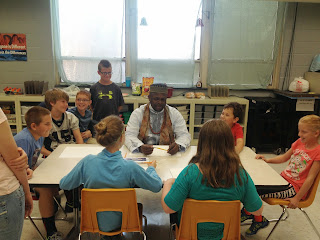Students dressed in historically accurate attire and packed traditional lunches for our trip. I'll bashfully admit my own hoop skirt got caught in the bus as I gracefully tried to exit. Historical reenactment isn't as easy as it looks. Luckily my students did an amazing job (as always) representing our school.
Our students began their field trip by visiting the black smith. He spent a portion of his morning explaining the art of metal work and created a metal rose for the students.
Next the children revisited the one room school house where they learned the history of one of Rupert's first schools. Children sat in the desks and listened to our guest speaker about the early days of education.
After school let out, our students visited the historic exhibit building. Students learned about broom making, chair caning, and wood work from friendly artisans. One gentleman share with us some historic find from outhouses around the state. He even let us keep an ink jar dated from around 1870.
After our historic tours, it was the student's turn to present their knowledge of history. Students took turns teaching fair visitors how to play historic games. Students played the game of graces, created yarn dolls, classic outdoor games, and with wooden toys such as Jacob's ladders to name a few.
Students who liked studying this time period should consider visiting the following PA Locations with Family:
American Civil War Wax Museum -- 297 Steinwehr Avenue, Gettysburg, PA
The Asa Packer Mansion Museum -- P.O. Box 108, Jim Thorpe, PA

















